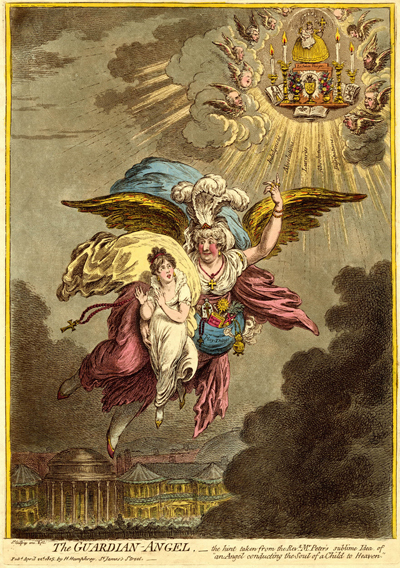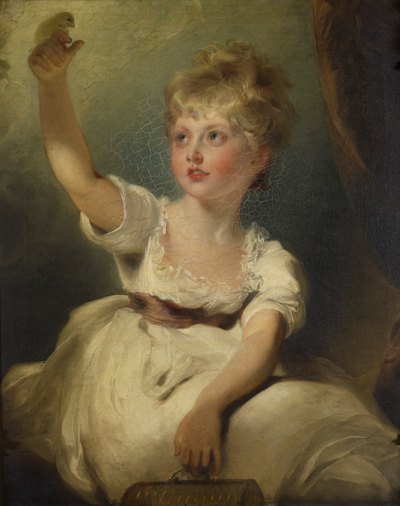The Guardian Angel
The Guardian Angel is one of Gillray's anti-Catholic prints prompted by a custody dispute over six-year old Minney Seymour which pitted the Catholic Mrs. Maria Fitzherbert who had (at Minney's deceased parents'request) raised the child since she was a month old against the child's Protestant paternal and maternal uncles, who wished now to take Minney away from Mrs. Fitzherbert lest the child be converted to Catholicism. Reports of the court proceedings which began March 29, 1805 appeared in numerous newspapers including The Courier, London Star, British Press, London St. James's Chronicle, Gentleman's Magazine, and the Morning Chromicle. Mrs. Fitzherbert's interests were represented by the famous Whig lawyer, Thomas Erskine, and the extensive coverage of the proceedings was probably prompted by the larger and still unresolved question of Catholic Emancipation which was already being discussed (again) in the newspapers, though not yet formally presented in Parliament until May.

© Trustees of the British Museum
From the beginning of Gillray's career, anything that suggested an inclination towards Catholicism was like a red flag before a bull, provoking satiric prints in which monitory images of Catholic fanaticism were called up in droves. Examples include Grace before Meat, or a Peep at Lord Peter's (1788), Wife & No Wife, or a Trip to the Continent (1786), and especially Dido Forsaken (1787) where Mrs. Fitzherbert had also been portrayed as a corrupting Catholic influence—in that case over the Prince of Wales.
The Guardian Angel is a parody of a painting (see below) by Matthew William Peters, An Angel Carrying the Spirit of a Child to Paradise. Gillray had alluded to Peters' work before in The Accusing Spirit which Flew up to Heaven's Chancery. . . (1791) and parodied it in A Modern Cherub (1791). Here the Guardian Angel is Mrs. Fitzherbert identified by her characteristic hooked nose, the three large plumes on her head (the emblem of her secret husband, the Prince of Wales), and the view of Brighton below where she had a residence. Around her waist is a large pouch labeled "Play Things," presumably for the child, Minney. But, in fact, they are collection of Catholic paraphernalia, demonstrating how Mrs. Fitzherbert is puportedly "educating" the child. Items include a rosary, a smoking censer, a monstrance, and, most prominently, a "Brighton Breviary" containing the Catholic service and accompanying prayers for each day of the year.

© Trustees of the British Museum
As if that were not already a sufficient indictment, Mrs. Fitzherbert gestures upwards to a kind of French-Catholic/Whig Heaven dedicated to the Virgin Mary. On opposite ends of the altar below Mary, we can see two books. One shows the Catholic pope; the other, the seven headed monster of Revelations. In the center of the altar is (presumably) the all too corporeal body of Christ emerging from the chalice per Roman Catholic belief that the Eucharist IS the body and blood of Christ. Surrounding the altar are choirs of Whig angels including all the usual suspects (from top-right): the Earl of Derby, Sir Francis Burdett, Charles James Fox, the Duke of Norfolk, Richard Brinsley Sheridan, William Windham, Lord Grenville, Charles Grey, Thomas Erskine, the Earl of Carlisle, and Lord Holland? Radiating from the altar are streams of light labeled with age-old Protestant bugaboos, including "Indulgences," "Absolutions," "Luxuries," and "Dissipations."
In January 1805, a print published by Fores called To Be or Not to Be A Protestant showed Mrs. Fitzherbert (once again as a Catholic apologist with cross and rosaries), asserting her right to raise the nine year old daughter of the Prince of Wales Princess Charlotte, in any way she chose. The Prince was between mistresses and had reconciled with Mrs. Fitzherbert in 1804, so Mrs. Fitzherbert did have opportunities to see his daughter, and by some accounts, they were fond of one another. So it is probably not surprising that the child in The Guardian Angel though certainly intended for Minney Seymour bears some resemblance to the painting of the young Princess Charlotte. The ambiguity and the ever-present suspicion of Catholicism behind it would have been useful to Gillray.

Princess Charlotte
[1800]
© Wikimedia
Sources and Reading
- Commentary from the British Museum on The Guardian Angel.
- Draper Hill, Mr. Gillray The Caricaturist, 1965, p. 121n
- "Maria Fitzherbert," Wikipedia
- "William Peters (painter)," Wikipedia
- "Matthew William Peters, R.A.," A Dictionary of Irish Artists
- "Princess Charlotte of Wales," Wikipedia
- Thomas Wright and R.H. Evans, Historical and Descriptive Account of the Caricatures of James Gillray #533
- Thomas Wright and Joseph Grego, The Works of James Gillray, the Caricaturist; With the History of His Life and Times, pp. 318-19.
Comments & Corrections
NOTE: Comments and/or corrections are always appreciated. To make that easier, I have included a form below that you can use. I promise never to share any of the info provided without your express permission.